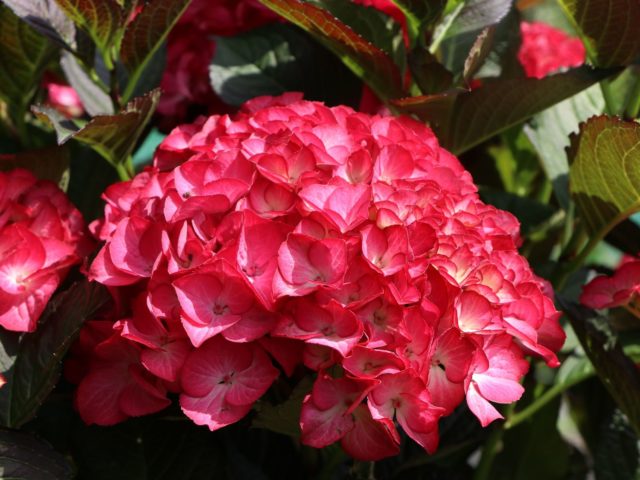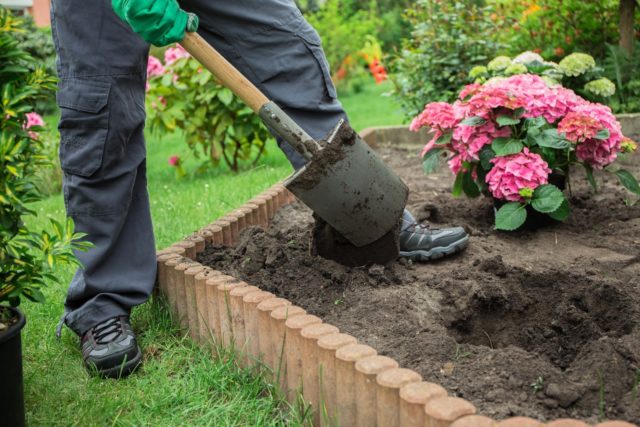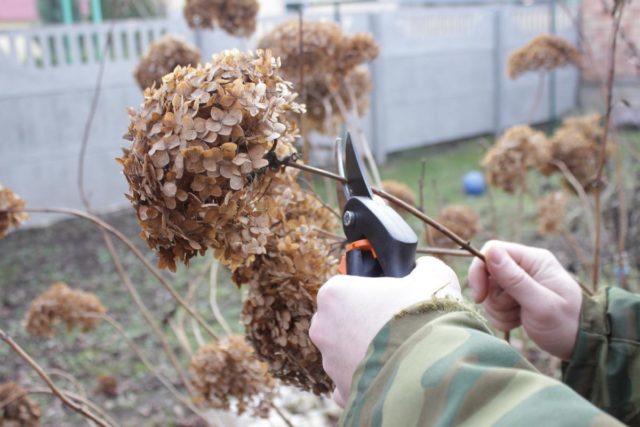Content
Hydrangea Red Angel is a novelty of 2015 from a series of dark-leaved Black Diamonds. The variety is distinguished by spectacular pink-red inflorescences, which change their color throughout the entire flowering period. And in combination with dark green foliage, Angel Red hydrangea looks especially elegant. But in order for the flowering to be lush annually, it is necessary to take into account some of the features of this type of culture.
Description of hydrangea Red Angel
This variety is characterized by compact shrubs with erect shoots, the height of which does not exceed 1.5 m when grown in the open field and not more than 0.6 m in pots. Leaves are oval, pointed at the top and jagged on the sides. They are often located on shoots. They are large in size, 7.5-10 cm long. The plates have a dark green tint with a brown tint along the edge. Young leaves of a purple hue with pronounced green veins.
The flowers of the Red Angel hydrangea are sterile, collected in globular inflorescences with a diameter of 20 cm.Their color varies from pink to deep red, depending on the stage of flowering and the acidity of the soil.
The flowering period of Angel Red hydrangea begins in July and lasts until September with the correct shelter of the plant for the winter. The root system of the shrub is branched and superficial. Life expectancy is about 50 years.
Annual growth does not exceed 20 cm in height and width. At the same time, the bush develops organically and maintains a natural balance, so the inflorescences are formed commensurate with the development of new shoots.

Adult Red Angel hydrangea forms up to 20 ball-shaped inflorescences annually
Hydrangea Red Angel in landscape design
This variety is distinguished by compact bushes that will look good on a flower bed near a house or a veranda. It is also recommended to use the Angel Red variety as a decoration for a flower garden near a recreation area.
The Red Angel hydrangea also looks spectacular when grown in containers that can be installed on an open terrace or at the entrance to a house. This variety is also suitable for hedges, which will allow you to highlight areas on the site.
Winter hardiness of hydrangea large-leaved Red Angel
The cold hardiness of this Red Angel is average. The plant is able to withstand temperatures as low as -23 degrees. But, since flowering occurs on last year's shoots, an obligatory shelter for the winter is required.
Planting and caring for large-leaved hydrangea Red Angel
In order for the Angel Red hydrangea to fully develop and bloom profusely, certain planting and care rules must be followed. Only in this case can the desired result be achieved.
Selection and preparation of the landing site
Angel Red needs to find a place in partial shade, as burns form on the petals and leaves in direct sunlight. Therefore, the best option is for the bush to be in the shade at noon, and well lit in the morning and evening.It is also important that the plant is sheltered from a draft, therefore it is recommended to plant a hydrangea on the eastern side of the site, not far from a fence, wall or gazebo.
Angel Redu, like other types of culture, the level of acidity is important, since the shade of flowers depends on it. Slightly acidic soil is considered the best option.
The site for the hydrangea must be prepared 2 weeks in advance by digging it to the depth of the shovel. Then you need to make a planting hole 60 cm wide and 40 cm deep, and then fill it with a nutrient mixture. To do this, mix the following components:
- 2 pieces of turf;
- 1 part of humus;
- 1 part peat;
- 20 g of potassium sulfide;
- 30 g superphosphate.
Hydrangea Red Angel prefers clay soils and rich in humus. Therefore, no sand should be added when planting.
This plant requires sufficient space, so it must be planted at a distance of 2.5-3 m from trees and other shrubs. In a row between plants, a distance of 1.5 m should be observed, and when grown as a hedge - about 1 m.
Planting rules for hydrangea large-leaved Red Angel
It is possible to plant Red Angel hydrangea in a permanent place in spring and autumn at a stable temperature above +10 degrees, regardless of the time of day. 2-year-old seedlings take root most quickly.

When planting, the root collar of the seedling should be at the level of the soil surface
Landing procedure:
- Make a small elevation in the center of the landing pit.
- Spread out the roots of the seedling and remove damaged areas if necessary.
- Place the plant on a raised center.
- Sprinkle soil over the roots, shaking the seedling lightly to fill in any voids.
- Compact the soil at the base, water the plant abundantly.
The next day, cover the root circle with peat.
Watering and feeding
Hydrangea Red Angel needs regular watering in the absence of seasonal rainfall. The bush develops well if its root system is constantly in a slightly humid environment. Therefore, the plant should be watered as the topsoil dries up, followed by loosening no deeper than 5 cm in order to improve air access to the roots.
It is also important to remove weeds in the root circle in a timely manner, as they will take up most of the nutrients.
Top dressing of the bushes must be started in the 3rd year if the nutrient mixture was used during planting. During the period of active growth, which lasts until the end of May, it is necessary to use urea at the rate of 30 g per 10 liters of water, as well as fermented organic matter: mullein 1:10 or bird droppings 1:20.
2 weeks before flowering, in the period from mid-June, it is necessary to use mineral fertilizers in a proportion of 45 g of potassium sulfate and 70 g of superphosphate per 10 liters of water. This feeding should be done twice with a frequency of 10 days.
Once every 3 years, a month before sheltering for the winter, Red Angel hydrangea bushes should be fed with bone meal. To do this, it is necessary to scatter fertilizer on the soil surface, followed by embedding in the ground at the rate of 100 g per 1 sq. m.
Pruning hydrangea large-leaved Red Angel
You need to cut this hydrangea variety correctly, otherwise flowering may never come. Therefore, in the fall, only sanitary cleaning of the bushes can be carried out, cutting off the damaged shoots that interfere with the growth of the rest. Young branches of this year cannot be shortened, since it is on them that flower buds are laid for the next season.
The life expectancy of shoots in the large-leaved hydrangea Red Angel is 4-6 years. After this age, they should be removed at the base, which stimulates the growth of replacement shoots.

It is recommended to prune shoots in the fall after leaf fall or in early spring before the start of sap flow.
Preparing for winter
Hydrangea Red Angel needs a must-have shelter for the winter to preserve the flower buds until next season. Therefore, when the foliage falls, it is necessary to cover the soil near the bush with spruce branches. Then lay the shoots on it and fix them so that they do not rise. Lay another layer of spruce branches on top and cover with agrofibre. After that, secure the shelter with a load. In the absence of spruce branches, it can be replaced with fallen leaves.
Additionally, it is necessary to mulch the root circle with a layer of peat 10-15 cm thick. This is due to the fact that Angel Red hydrangea has a superficial root system and in the absence of snow it can freeze slightly.
Reproduction of hydrangea Red Angel
Hydrangea Angel Red propagates by dividing the bush and cuttings. The first method is recommended to be used in the fall, which will allow you to get well-rooted seedlings by the spring. To do this, you need to dig up an adult bush and use a pruner to divide it into several parts, each of which should have well-developed root processes and several shoots.
The second method is best used when you need to get a large number of Angel Red seedlings. Cuttings should be cut from young woody shoots. Moreover, each part must have one internode. The upper cut must be made straight, and the lower cut oblique. Also, the leaves must be cut in half. After that, plant the cuttings in the ground and make a small greenhouse. Rooting occurs after 20-25 days. You can transplant Angel Red's young seedlings to a permanent place at the age of 2 years.
Diseases and pests
Hydrangea Angel Red has a high natural immunity. But if the basic requirements of the culture are not met, the susceptibility to the effects of pests and diseases increases.
Possible problems:
- Chlorosis... This disease develops when there is a lack of iron in the soil. In this case, the leaves of the hydrangea become discolored, the inflorescences become smaller, and excessive fragility of the shoots appears. To eliminate the disease, it is necessary to water the diseased bushes twice with an interval of a week with iron chelate at the rate of 5 g per 5 liters.
- Gray rot... The main symptom of the disease is weeping brown spots with a gray coating that appear on leaves, shoots and flowers. For treatment, the bushes should be sprayed with "Fundazol" and Bordeaux mixture.
- Rust... The disease develops with excessive application of nitrogen to the soil. It is characterized by the appearance of a rusty color of the leaves. To fight, you should use "Skor", "Topaz", "Falcon".
- Spider mite... This pest cannot be seen with the naked eye. A lesion can be recognized by small yellow dots on the leaves, which subsequently become marbled. To destroy the pest, the bushes should be sprayed with Aktellik.
Conclusion
Hydrangea Red Angel is a spectacular perennial shrub with an unusual color of inflorescences. Thanks to this, this look will look elegant, both in group compositions and in single landings. But it should be remembered that Angel Red's flowering occurs on last year's shoots, therefore this species needs a mandatory shelter for the winter.
https://www.youtube.com/watch?v=rdrFAllLEqY








